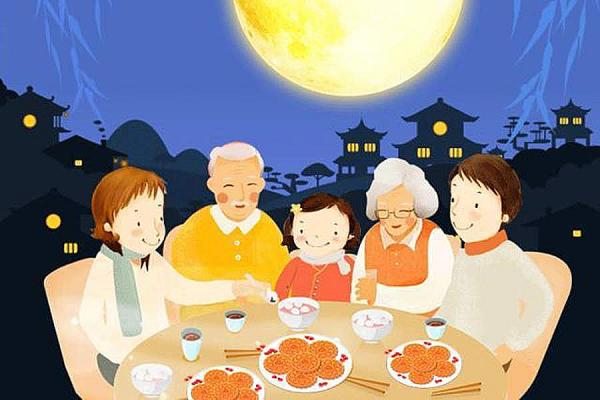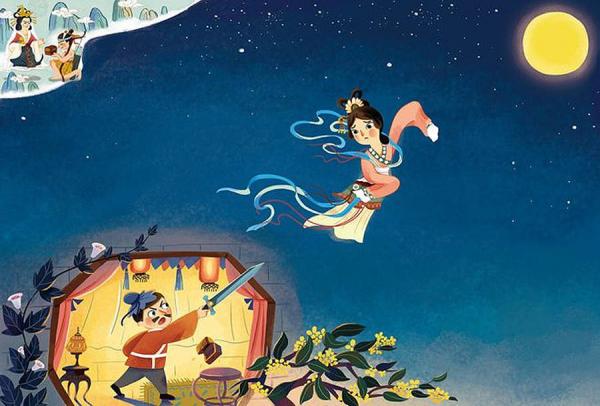Mid-Autumn Festival 2025 – What is It & What to Do?
The Mid-Autumn Festival, a cherished Chinese and East Asian tradition, celebrates unity and abundance under the radiant full moon. Families, relatives, and friends gather to share delectable mooncakes, symbolizing harmony. Lanterns aglow, this festival evokes a sense of togetherness, happiness and gratitude, making it a cultural treasure that transcends generations.
What is Mid-Autumn Festival?
The Mid-Autumn Festival is one of the most romantic Chinese festivals and China's second largest traditional festival after the Spring Festival. It takes place on the 15th day of the eighth lunar month, also known as the "Night of the Moon" when the moon is supposedly at its fullest and roundest.
For Chinese people, the full moon is a symbol of family reunion. During the Mid-Autumn Festival, family members gather together to taste moon cakes and appreciate the round moon. The date changes annually in the Western calendar.
In China, the moon represents the mother or female in matrilineal society. Traditionally, it also expresses people's worship of life and is used to judge the reincarnation of time. The round shape of the moon symbolizes reunion, nostalgia, homesickness, praying for a bumper harvest, happiness, wealth, and is now an important cultural heritage.

Facts of Chinese Mid-Autumn Festival
- In Chinese: 中秋节, Zhongqiu Festival
- Other names: Moon Festival, Moon-worship Festival, Mooncake Festival, Reunion Festival
- Significance: the second largest festival in China.
Mid-Autumn festival, Dragon Boat Festival, Lunar Chinese New Year, and Tomb-sweeping day and known as China's four traditional festivals.
- History: 3000+
Date – When is Chinese Mid-Autumn Festival 2025
| Year | Date | Day | Holiday |
|---|---|---|---|
| 2025 | Oct 6 | Saturday | Oct 4 to 6 |
| 2024 | Sep 17 | Saturday | Sep 15 to 17 |
| 2023 | Sep 29 | Friday | Sep 29 to Oct.6 (together with China National Day Holiday) |
| 2022 | Sep 10 | Saturday | Sep 10 to 12 |
Origin – the legend of Mid-Autumn Festival
There are three versions of the story of Mid-Autumn Festival, but the story of Chang'e flying to the moon is more widespread.
It is said, there were ten suns in the sky in the ancient time, which made crops die and people couldn’t live. A man named Houyi (后裔) with great power, he sympathized with the people who are in the suffering. So he climbed to top of the Kunlun Mountain, and then shut down nine suns for the benefit of the people.
Houyi was so respected and loved by the people, soon he married a beautiful and kind wife named Chang 'e (嫦娥). Many young men came to learn shooting from Houyi, Peng Meng (蓬蒙) also mixed in.
One day, Houyi encountered the queen of heaven. She rewarded Houyi an elixir and told him if he and Chang'e share the elixir on the 15th day of the eighth lunar month, they can both enjoy eternal life; but if only one take it, that one will ascend to heaven and become immoral. Houyi went back home and told Chang'e but wicked Feng Meng heard about the plan and decided to take the medicine away.

Some days later, Houyi went out for shooting with his students, Peng Meng lied to escape the practice. After they leaving, he threatened Chang'e to hand out the elixir by sword. Chang'e couldn’t want the precious elixir fall into bad guy, so she gulped down the elixir. At that moment, Chang'e got light and flew throw the window into the sky. She landed on the moon so that she can see the earth.
In the evening, Houyi backed home, knowing what happened, he got very angry and shocked. He rushed to Peng Meng’s house to kill him but Peng Meng had already run away. He cried out sadly, calling Chang'e’s name. Suddenly, he saw a figure in the moon, looked like his wife so much, he wanted to get closer to it, but no matter how he struggled, there was still a long distance.
Only can he do to express his thought of love is to serve Chang'e’s favorite food in the yard when the moon gets the closest to the earth on the annual lunar August 15. When people knew that, they all did as Houyi did to pray for peace and health. Since then, the Mid-Autumn festival worship as the customs of the folk spreads.
History of Mid-Autumn Festival
Mid-Autumn Festival originated from the Moon sacrifices in ancient times. In ancient China, emperors followed the rite of offering sacrifices to the sun in spring and to the moon in autumn. Later aristocrats and literary figures helped expand the ceremony to common people. Historical books of the Zhou Dynasty (1066 B.C. - 221 B.C.) have had the word "Mid-Autumn". At that time, people hold ceremonies to greet winter and worship the moon.
The custom was passed down to the Tang Dynasty (618-907 A.D.) when people enjoy and worship the full moon. In the Song Dynasty (960-1279), the 15th day of the eighth lunar month was formally named the Mid-Autumn Festival. People sent round moon cakes to their relatives as gifts in expression of their best wishes of family reunion. And since the Ming (1368-1644) and Qing dynasties (1644-1911), the custom of Mid-Autumn Festival celebration has become unprecedentedly popular.
Food – What to eat for Mid-Autumn Festival 2025?
Mooncake
Eating moon cakes is the best-known custom in Mid-Autumn Festival, in round shape, measuring about three inches in diameter and one in thickness. For Chinese people, those palm-sized round cakes symbolize family unity and perfection. They eat moon cakes to express their homesickness and love for their family member.
A traditional moon cake is made of a sweet bean-paste filling with golden brown flaky skin. And a golden yolk from a salted duck egg, which looks like a bright moon, was placed at the center of each cake. The flavor of moon cake also varies based on region. Moon cakes in Guangdong are wrapped in a pastry-like crust and are famous for their meticulously prepared fillings; while Moon cakes in Peking areas are crisp with savory outer crust.
Over time, both crusts and the fillings of moon cakes have diversified, for changing taste preferences and people would buy it from stores as early as in 7th lunar month. Moreover, to adapt to today's health-conscious lifestyle, fat-free and even high-fibre low sugar moon cakes also appeared. Customers can freely choose and pick the size and filling of moon cakes that suits their taste and diet.

Pomelo
At some parts of China, eating pomelo on Mid-Autumn Day is an indispensable activity. The name of this fruit is homophonous with that for "blessing", and is considered auspicious. It features pointed top, round bottom and thin skin with honey sweet taste.
Escargots
In southern China especially Guangdong province, most of the family have the habit of cooking escargots. Around Mid- Autumn Festival, there are no small snails in the belly of field snails, so the meat is fat.
Osmanthus’ flowers wine
Autumn is the season when osmanthus flowers are in full bloom; people enjoy the moonlight and smell the fragrance of osmanthus flowers while having a cup of flower wine, drinking flower wine means the family becomes sweet.

Activities – How to celebrate this Mid Autumn Festival in 2025?
Worship the moon
The custom of worshipping the moon can be traced back to 2000 BC, people hold ceremonies to greet the winter and the moon. This became popular in Tang Dynasty, then in Song Dynasty, the custom of Mid-Autumn Festival celebrations became unprecedented popular. Nowadays, activities vary in different parts of the country, such as eating moon cake, lighting lanterns and fire dragons, playing lion dance or dragon dance, burning incense and some other interesting practices.
Family reunion
Mid-Autumn Festival is an evening celebration for family reunion. Most activities follow the custom of worshipping the moon in ancient times. At the night of Mid-Autumn Festival, people invite friends and relatives to hold family reunion feast for celebration. After the feast, they would sacrifice moon cakes, fruits and wine to the full moon at the open space. Every one prays for the blessing of Moon Goddess.
Then, they would admire the full moon, taste moon cakes, drinking, chatting even dancing under the moon. Actually, contents of celebration varied in different areas of China: putting pomelo rinds on one's head, lighting lanterns on towers, floating sky lanterns, burning incenses to the moon, planting Mid-Autumn trees, perform the Fire Dragon Dances...
Make lanterns
The Mid-Autumn festival is one of the three major lantern festivals in China. Indeed, the lantern show in the Mid-Autumn festival is not as big as that of the Lantern Festival, make lanterns mainly among families. In Guangzhou and Hong Kong area, children with the help of their parents make paper lanterns and put them higher, or launch Kongming lanterns into sky. In Nanning, Guangxi, there are also simple pomelo lantern, pumpkin lanterns, orange lanterns. The so-called pomelo lantern is to hollow out the pomelo pulp, carve out a simple figure, put on a rope, light candles inside.

Moon Cake Festival Celebrated in other Asian countries
Not only in China, but also in many Asian countries, celebrating the Mooncake Festival is still popular.
● In Vietnam, different from Chinese Moon festival, children and carps are the heroes and custom feature of Vietnamese Mid-Autumn festival. Parents will spend more time to company with kids on the day, and kids will run around with carp lantern which means "jumping through dragon gate(gaining fame)" when they grow up.
● In Japan, it’s called the Fifteenth Night. Japanese get together, eat reunion dinner and moon cakes, and eat rice dumplings while enjoying the sight of the moon. Since it’s also in a harvest season, the Japanese also hold various celebrations to show their gratitude for the blessings of nature, such as worship, tugging of war, playing lion dance, etc.
● In South Korea, people call Mid-Autumn Festival “Chuseok”, giving gifts to relatives and friends is also the custom of the Korean Mid-Autumn festival, so they also called the Mid-Autumn festival "Thanksgiving”. With a three-day holiday, it is a big festival in South Korea; people usually visit their families during the festival.
●In Malaysia, Philippine and Singapore, Chinese communities in some places hold lantern parades to celebrate the Mid-Autumn festival. In addition to dragon and lion dances, floats carrying Chang'e and seven fairies roam during the festival.

Best places to visit during Mooncake Festival
The Mooncake Festival is a great time to visit China and experience the country's rich culture and traditions. While it's tempting to visit the top attractions, they can be overcrowded during the festival. Instead, consider exploring some of the lesser-known cities and towns that offer a unique and authentic experience.
One such city is Guiyang, which is renowned for its stunning landscape and mouthwatering cuisine. Visit your neighborhood markets and sample some of the customary Mooncake Festival fare, including mooncakes and osmanthus wine. Guangzhou, which is renowned for its Cantonese cuisine and exciting nightlife, is an additional choice. You can wander the streets and take in the holiday decorations, or you can tour the city's numerous temples and museums.
Hong Kong should be on your travel itinerary if you're seeking for a more cosmopolitan experience. There are several cultural events and performances taking place during the Mooncake Festival, and the city is awash in colorful lantern displays. The city's numerous eateries and street sellers are also offering mouthwatering Mooncake Festival fare.
Mid-Autumn Fesetival FAQ:
Who (What Countries) Celebrate Mid Autumn Festival?
The majority of East Asian civilizations, including those in China, Taiwan, Hong Kong, Macau, Vietnam, and certain areas in other nations with sizable East Asian populations, celebrate the Mid-Autumn Festival. It has cultural and historical significance in many cultures of the world.
How Long is Mid Autumn Festival?
Typically, the Moon Cake Festival lasts for one day. While families join together to buy or create mooncakes, collect the requisite materials for offerings, and plan celebratory activities, the celebrations and preparations leading up to the festival might last for many days. In many regions of China, celebrations may even last into the days that follow, ushering in a brief time of festivity.
What Happens to the Moon in Mid-Autumn Festival? Is the Moon Full during Mid-Autumn Festival?
Yes, the full moon is frequently linked to the Mid-Autumn Festival. Traditionally, as we mentioned earlier, the festival falls on the 15th day of the 8th lunar month, and during this time, the moon is typically at its fullest and brightest. A significant celebration symbol is the full moon.
Lanterns are lit to create a cozy and festive environment as families and friends gather to admire the beauty of the full moon. Mooncakes are consumed, shared with loved ones, and offered to the moon. This Chinse Moon Festival's enchanting celebrations are made even more magical and significant by the full moon's brightness.


